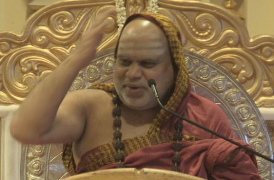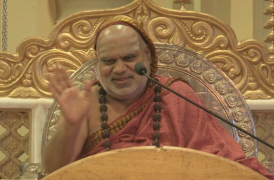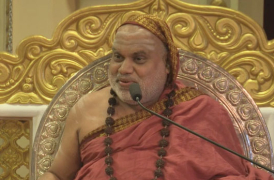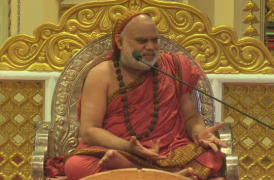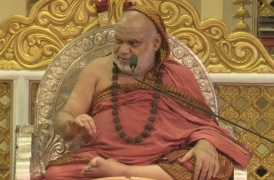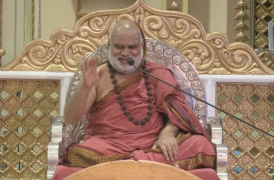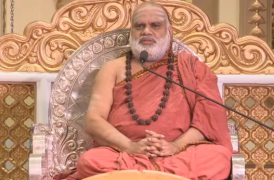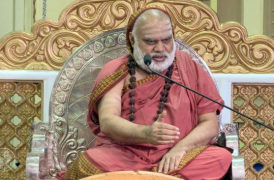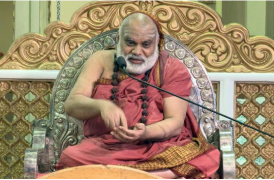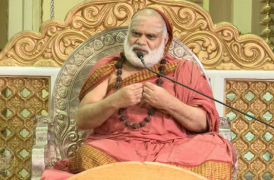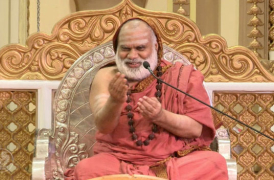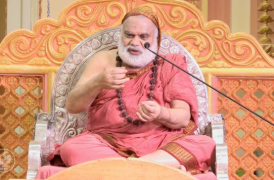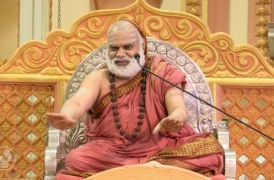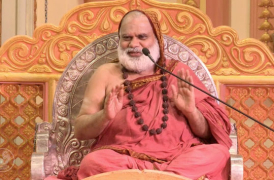
Chennai: JULY 8 – SEPTEMBER 5, 2012
Adhyatma Vidya Vrishti in Chennai: A Shower of Spiritual Wisdom
The highlight of this Chaturmasya was the series of Vedantic Anugraha Bhashanams in Tamil delivered by the Jagadguru in the evenings on Wednesdays and Sundays (excluding Ekadashis and other days when special events were organized). The Jagadguru delved into various topics and in particular, chose topics from the Brahma Sutra Bhashya of Jagadguru Sri Adi Shankaracharya. The Jagadguru also mentioned in one of the Bhashanams, that it is a practice of the Acharya to engage in Bhashya Paatam – teach the Bhashyas in Chaturmasya, and some ardent disciples had approached Him with this request. The Jagadguru gave this series of Anugraha Bhashanams with the view of satisfying their request, and to benefit all Astikas. The Anugraha Bhashanam series on Vedanta was truly an Adhyatma Vidya Vrishti – a shower of spiritual wisdom that was eagerly consumed by sincere seekers. The audience for the Bhashanams ranged from scholars, upanyasakas, judges, professionals, householders interested in Vedanta, devotees and disciples young and old. The entire series was telecast live on Sankara TV.
This entire series of discourses, with a run-time of about 8 hours has been released on DVD in two volumes and is available for purchase at Sringeri Sharada Peetham and its branch Maths across the country. A version with English sub-titles will be released next year and made available to an international audience via Amazon.com
DISCOURSE ONE. ELIGIBILITY FOR VEDANTIC STUDY & PRACTICE (July 8, 2012)
:: “Sadhana Chatushtaya” – the four fold qualifications for an aspirant of Vedanta.
:: Need to approach a Guru
DISCOURSE TWO. SIX QUALITIES OF AN ASPIRANT OF VEDANTA (July 11, 2012)
:: “Shamaadi Shatkam” – the six qualities of an aspirant of Vedanta
DISCOURSE THREE. QUALITIES OF A DISCIPLE (July 15, 2012)
:: Qualities and character of a Shishya (Disciple)
DISCOURSE FOUR. THE ATTITUDE OF A SINCERE SEEKER (July 18, 2012)
:: The attitude of a sincere seeker in the Nivritti Marga (path of renunciation) and their behaviour in various circumstances
DISCOURSE FIVE. ESSENCE OF ADVAITA & UNDERSTANDING CREATION (July 22, 2012)
:: Essence of Advaita (Non-Dualism)
:: Address questions raised without a proper understanding of the non-difference between Brahman (Supreme Reality) and the Jiva
:: An understanding of Creation by providing meaningful answers to relevant questions
DISCOURSE SIX. MATERIAL & INSTRUMENTAL CAUSE OF THE WORLD (July 25, 2012)
:: Just as a pot made of mud (material cause) by a potter (instrumental cause), Ishwara is the material and instrumental cause of the world
:: Address doubts that arise when Ishwara is taken to be the material cause
DISCOURSE SEVEN. UNDERSTANDING ADVAITA & MITHYA (Aug 2, 2012)
:: Objections that arise when the Jiva is stated as being non-different from Brahman (the Absolute Reality), and when everything except Brahman is stated as Mithya
:: How can the experiencer and experienced be non-different to each other? If everything is Mithya, are not the Vedas Mithya too? How then can true knowledge be attained by Vedic statements?
:: Above questions are addressed to give a proper understanding of Advaita and Mithya
DISCOURSE EIGHT. CAUSE: BRAHMAN, EFFECT: THE WORLD (Aug 5, 2012)
:: Clarifying how the world has risen from Brahman and finally dissolves into Brahman
:: Rational thinking and logic alone cannot lead you to Reality
:: Need for a proper understanding of Vedanta as explained by Sri Adi Shankaracharya
DISCOURSE NINE. THE NATURE OF ISHWARA (Aug 15, 2012)
:: If Ishwara is the cause of this world and the world is said to be a transformation of Ishwara, how can Ishwara exist once he has transformed into the world?
:: If Ishwara is impartial why should he place some people in good situations and make others suffer?
DISCOURSE TEN. IS AKASHA (ETHER) BRAHMAN TOO? (Aug 19, 2012)
:: Ishwara creates the Universe by first creating the Panchabhutas (five elements). Of the Panchabhutas, Akasha is termed as Nitya in the Upanishads and like Akasha, Brahman is also termed as Nitya
:: If that is the case, is not Akasha eternal just like Brahman? Does this not contradict the statement that the Eternal Truth is non-dual?
:: Brahman alone is eternal and Akasha too is created
DISCOURSE ELEVEN. UNDERSTANDING KARMA & ITS PURPOSE (Aug 22, 2012)
:: Moksha (cycle of births and deaths) can be attained only from Jnana
:: This cycle is set in motion by engaging in Karmas driven by desiring or engaging in prohibited actions
:: However one will not one get Moksha merely by abstaining from Kaamya Karma and Nishiddha Karma because no one can claim that they have never engaged in actions driven by desire (Kaamya) or abstained totally from prohibited (Nishiddha) actions
:: How is the Karma of a Jnani burned?
:: Karma is to be performed for Chitta Shuddhi (purification of the mind)
DISCOURSE TWELVE. JNANA: PATH TO MOKSHA, EVEN FOR DEVAS (Aug 26, 2012)
:: Jnana is the path to Moksha even for Devas
:: Do Devas have Shariras (bodies) to work towards attaining Jnana?
:: If they do have bodies, how can they be present at multiple places?
DISCOURSE THIRTEEN. THE IDENTITY OF BRAHMAN & JIVA (Aug 29, 2012)
:: If only one entity is true, is it Jiva or Ishwara?
:: If it is Ishwara, then what is the role of the Shastras?
:: If it is Jiva, who must take the effort for Moksha?
:: Who brought about Creation and who is there to be known?
:: Identity of Brahman and Jiva is explained by answering the above questions
DISCOURSE FOURTEEN. CLARIFICATIONS ON SADHANA (Sep 2, 2012)
:: Who is eligible to do Karma?
:: Efficacy of Mantra Japa
:: The purpose of Sannyasa
:: The importance and need of engaging in Sadhana
DISCOURSE FIFTEEN. FURTHER CLARIFICATIONS ON JNANA & JNANI (Sep 5, 2012)
:: Is it true that Brahma Jnana leads to Moksha for there are instances in the Itihasas and Puranas where we find that even Brahma Jnanis are seen to take further births?
:: Answer for the above based on understanding of Prarabdha Karma
:: Significance of the time of death, referring to the scriptural statement that dying in the Uttarayana is preferred while dying in Dakshinayana definitely causes return to Samsaara
:: Above statement does not apply to the passing away of a Brahma Jnani
At the end of the last Bhashanam, the Jagadguru expressed joy that everyone had listened with great interest and attention. Even if some people did not seem to understand some of the abstruse concepts of Vedanta, the Jagadguru appreciated the sincerity of the audience and blessed that everyone attain Shreyas. The devotees were left with a feeling of blessedness as well as the thirst for more such Bhashanams from the Jagadguru.
